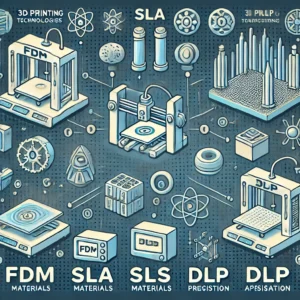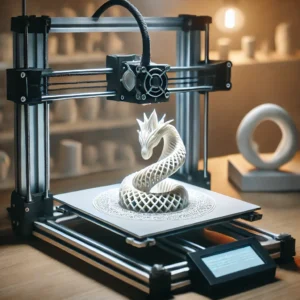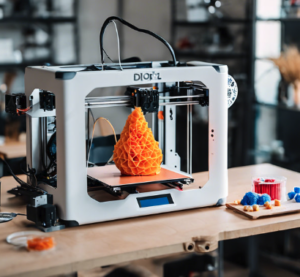
Unlock the world of 3D printing with this comprehensive guide for beginners. Learn about essential tools, techniques, types of printers, materials, troubleshooting tips, and expert advice to get started on your 3D printing journey in 2024.
3D printing, or additive manufacturing, has revolutionized healthcare and aerospace industries. By enabling the creation of complex objects directly from digital models, it bypasses traditional manufacturing limitations and opens a world of possibilities for creators. Whether you’re an entrepreneur prototyping a new product, an artist crafting intricate designs, or a hobbyist exploring a new medium, 3D printing is a tool that can transform your ideas into reality.
The journey into 3D printing, however, can be daunting. Knowing where to begin is challenging with various printers, materials, and techniques available. This guide is designed to demystify 3D printing, offering beginners a roadmap to navigate this fascinating technology. From understanding the basics to troubleshooting your first prints, this article will provide the knowledge you need to confidently start your 3D printing adventure.
What is 3D Printing?
At its core, 3D printing is the process of creating three-dimensional objects by building them layer by layer from a digital file. This method contrasts with traditional subtractive manufacturing techniques, which carve or cut objects from a larger material block.
How Does It Work?
3D printing begins with a digital 3D model created in CAD (Computer-Aided Design) software or downloaded from platforms like Thingiverse. This model is then processed by slicing software, which converts it into instructions (G-code) that the printer can follow. The printer reads these instructions and deposits or solidifies material layer by layer until the object is complete.
Real-World Applications
3D printing’s versatility is evident in its applications across industries:
- Prototyping: Designers use it to quickly iterate and test products.
- Healthcare: Prosthetics, surgical tools, and even bio-printed tissues rely on 3D printing.
- Aerospace: Lightweight, durable parts are created for aircraft and spacecraft.
- Education: STEM programs integrate 3D printing for hands-on learning experiences.
By understanding its foundational principles and broad applications, beginners can better appreciate the transformative potential of 3D printing.
Types of 3D Printers
1. Fused Deposition Modeling (FDM)
FDM is the most common and accessible type of 3D printing. It involves heating a thermoplastic filament and extruding it through a nozzle onto a build platform, layer by layer.
- Cost: FDM printers are affordable, with entry-level models starting at $200.
- Materials: PLA, ABS, PETG, and more.
- Pros: User-friendly, great for prototypes and household items.
- Cons: Lower precision and surface finish compared to other methods.
2. Stereolithography (SLA)
SLA uses a UV laser to cure liquid resin into solid layers, offering high detail and smooth finishes.
- Cost: Mid-range SLA printers start at $300, with premium models exceeding $2000.
- Materials: Photopolymer resins.
- Pros: Excellent precision and surface quality.
- Cons: Resin can be expensive, and post-processing is required.
3. Selective Laser Sintering (SLS)
SLS uses a laser to fuse powder into solid layers, creating durable and complex parts.
- Cost: SLS printers are typically industrial-grade, starting at $5000.
- Materials: Nylon, polyamides, and other powders.
- Pros: No need for support structures, suitable for functional parts.
- Cons: Expensive and primarily used for advanced applications.
Selecting the right printer depends on your budget, goals, and the type of projects you plan to undertake.
Essential Tools for 3D Printing
Getting started with 3D printing involves more than just buying a printer. You’ll need a range of tools and accessories to ensure a smooth and efficient workflow.
1. The Printer Itself
Choose a printer that suits your needs. FDM models like the Creality Ender 3 are great for beginners due to their affordability and ease of use.
2. Materials
Different materials serve different purposes:
- PLA: Easy to use, ideal for beginners.
- ABS: Durable and heat-resistant.
- PETG: A balance of strength and flexibility.
- Resin: Offers high detail but requires careful handling.
3. Slicing Software
Programs like Cura and PrusaSlicer are essential for converting 3D models into printable instructions.
4. Adhesives
Tools like glue sticks, painter’s tape, or specialized bed adhesives help secure your prints during the process.
5. Post-Processing Tools
Once a print is complete, you’ll need tools like clippers, sandpaper, and polishing compounds to finish the job.
By assembling the right toolkit, you’ll be prepared to handle the challenges and intricacies of 3D printing.
Specifications Summary Table
| Specification | FDM (Fused Deposition Modeling) | SLA (Stereolithography) | SLS (Selective Laser Sintering) | DLP (Digital Light Processing) | SLS (Selective Laser Sintering) |
|---|---|---|---|---|---|
| Printing Technology | Extrudes heated filament through a nozzle. | Uses UV light to cure liquid resin layer by layer. | Uses a laser to sinter powdered material. | Uses digital projectors to cure resin layer by layer. | Uses a laser to sinter powdered material. |
| Layer Resolution | 0.1 – 0.4 mm | 0.025 – 0.1 mm | 0.1 – 0.2 mm | 0.025 – 0.1 mm | 0.1 – 0.2 mm |
| Print Speed | Medium to slow (approx. 20–100 mm/s) | Slow (approx. 10–30 mm/s) | Slow (approx. 10–50 mm/s) | Fast (approx. 20–60 mm/s) | Slow (approx. 10–50 mm/s) |
| Material Compatibility | PLA, ABS, PETG, TPU, Nylon, and more | Resin (variety of types: standard, flexible, durable) | Nylon, glass-filled nylon, aluminum, metal, and polymers | Resin (variety of types: standard, flexible, durable) | Nylon, glass-filled nylon, aluminum, metal, and polymers |
| Price Range | Budget to Mid-range (approx. $150–$2,500) | Mid-range to High-end (approx. $200–$5,000+) | High-end (approx. $5,000–$500,000) | Mid-range to High-end (approx. $500–$5,000+) | High-end (approx. $5,000–$500,000) |
| Ideal Use Case | Prototyping, hobbyist projects, low-cost manufacturing | High-detail prototypes, jewelry, dental models | Functional parts, industrial applications, small runs | High-detail, small to medium parts, prototypes | Industrial, functional parts, complex geometries |
| Post-Processing Needs | Low (supports removal, sanding) | High (cleaning, curing, sanding) | Low (sometimes cleaning or sintering) | Moderate (supports removal, curing, cleaning) | Low (minimal post-processing) |
| Printer Maintenance | Medium (regular nozzle cleaning and recalibration) | High (resin tank cleaning, UV light maintenance) | High (powder handling and laser calibration) | Moderate (monitoring light source, cleaning resin vat) | High (powder handling, laser calibration) |
| Precision | Moderate (good for general prototyping) | High (detailed prints, ideal for small, intricate designs) | High (suitable for detailed and durable parts) | High (detailed and complex prints) | High (detailed and durable parts) |
| Strength of Output | Moderate (depends on material used) | Low to moderate (depends on resin type) | High (strong and durable, suitable for functional parts) | Moderate (depends on resin type) | High (strong and durable) |
Explanation of Key Specifications
-
Printing Technology:
FDM uses heated filament to extrude through a nozzle to create the printed part. SLA and DLP printers use light to solidify resin layer by layer, providing high-resolution prints. SLS uses a laser to sinter powdered material into solid forms, while DLP uses digital projectors instead of lasers, making it faster. -
Layer Resolution:
The layer resolution refers to the thickness of each printed layer. FDM typically has the thickest layers, while SLA and DLP can print with extremely fine detail, making them better suited for intricate designs. SLS has good resolution but may not match SLA or DLP in terms of fine detail. -
Print Speed:
FDM is relatively slow, but customizable settings allow it to balance speed and quality. SLA is slower, but it excels at high-resolution prints for detailed models. SLS is also slower and best suited for industrial applications, whereas DLP has faster printing times compared to SLA, due to its light-based curing method. -
Material Compatibility:
FDM is versatile, supporting many common filaments like PLA, ABS, PETG, and TPU. SLA works mainly with resin, but it can produce parts with fine details. SLS supports a range of materials, including nylon and metal-based powders, making it ideal for functional and industrial-grade parts. DLP is similar to SLA in terms of resin usage but offers faster prints. -
Price Range:
FDM printers are the most budget-friendly, with prices ranging from under $200 for basic models to $2,500 for professional-grade systems. SLA and DLP printers are more expensive due to their high resolution and specialized materials. SLS printers are the most costly, with industrial models costing upwards of $500,000. -
Ideal Use Case:
FDM printers are perfect for hobbyists and prototyping, especially for creating functional parts at a lower cost. SLA and DLP are used for detailed prints like jewelry or dental models, whereas SLS excels in producing functional prototypes and parts for industries like aerospace and automotive. DLP is often used for smaller, high-detail parts. -
Post-Processing Needs:
FDM prints require minimal post-processing, mainly removing supports and occasional sanding. SLA prints require significant post-processing, including cleaning, curing, and sanding. SLS and DLP have moderate post-processing requirements, with SLS prints needing little more than cleaning and sintering, while DLP prints require curing and cleaning. -
Printer Maintenance:
FDM printers are relatively easy to maintain, with occasional cleaning of the nozzle and recalibration of the bed. SLA and DLP printers require cleaning of the resin tank, replacing the UV light, and ensuring the printer remains free from cured resin buildup. SLS printers need regular calibration and proper handling of the powder material. -
Precision:
SLA and DLP offer the best precision, making them suitable for detailed, intricate designs like jewelry or dental models. FDM offers moderate precision, with some limitations when printing smaller or more detailed objects. SLS also offers high precision and is great for functional parts with more strength. -
Strength of Output:
FDM prints depend on the material used, with PLA being more brittle and ABS being stronger. SLA prints, while precise, can be fragile depending on the resin used. SLS produces the most durable parts, especially using materials like nylon, glass-filled nylon, or metal powders. DLP prints offer moderate strength, mainly for prototypes and small functional parts.
By understanding the various specifications for each 3D printing technology, you can make more informed decisions about which printer best fits your needs. Whether you are a hobbyist looking for a budget-friendly FDM printer or a professional in need of high-precision, durable parts from SLS, there’s a 3D printing solution for you.
3D printing is an exciting and empowering technology that bridges the gap between imagination and reality. With the knowledge provided in this guide, you’re well-equipped to take your first steps into this innovative field. Whether you’re printing for personal projects or professional endeavors, 3D printing offers a world of creative opportunities. Dive in, experiment, and unlock the endless potential of this transformative technology.
FAQs:
1. What is the best 3D printer for beginners?
The best 3D printer for beginners is often an affordable and user-friendly FDM (Fused Deposition Modeling) printer. Models like the Creality Ender 3 or Prusa Mini+ are excellent starting points. These printers offer a balance of cost-effectiveness, ease of use, and community support. The Ender 3, for example, comes with a large online user base, making it easy to find tutorials and troubleshooting advice. Beginners can start with basic projects using PLA filament, a forgiving material that’s ideal for learning.
2. What materials can I use in 3D printing?
The materials you can use depend on your printer type. Common options include:
- PLA (Polylactic Acid): Biodegradable and easy to print with, suitable for beginners.
- ABS (Acrylonitrile Butadiene Styrene): Stronger and more heat-resistant, but trickier to print.
- PETG (Polyethylene Terephthalate Glycol): A durable material that’s resistant to moisture.
- Resin: Used in SLA printers, offering high detail and smooth finishes, but it’s more expensive and requires post-processing.
- Nylon: Ideal for functional parts due to its strength and flexibility, commonly used with SLS printers.
Each material has unique properties, so choosing the right one depends on your project needs, printer compatibility, and experience level.
3. What software is required for 3D printing?
3D printing requires three types of software:
- CAD Software: Used to design 3D models. Popular options include Tinkercad (beginner-friendly), Fusion 360, and Blender.
- Slicing Software: Converts the 3D model into instructions (G-code) for the printer. Free options include Cura and PrusaSlicer.
- Firmware: Runs on the printer itself to execute the G-code. Most printers come with pre-installed firmware, but advanced users may update it for additional features.
Learning these software tools is an integral part of mastering 3D printing.
4. How much does a 3D printer cost?
The cost of a 3D printer varies widely:
- Entry-Level FDM Printers: $200–$500. Ideal for beginners and hobbyists.
- Mid-Range SLA Printers: $300–$2000. Suitable for high-detail projects.
- Industrial SLS Printers: $5000 and above. Used in professional settings for functional parts.
Additional costs include materials, maintenance, and accessories, so budget accordingly.
5. What are common beginner mistakes in 3D printing?
Beginners often face challenges like:
- Improper Bed Leveling: A misaligned bed can lead to poor adhesion or failed prints.
- Using Incorrect Settings: Not adjusting parameters like temperature, speed, and layer height for different materials.
- Skipping Maintenance: Neglecting to clean the nozzle, check belts, or lubricate moving parts.
Avoiding these pitfalls requires patience, practice, and attention to detail.
6. How long does it take to print something?
Print times vary depending on the size, complexity, and layer height of the object. A small, simple model may take 30 minutes, while a detailed, large print can take several hours or even days. Adjusting settings like layer height (smaller layers take longer) and print speed can influence the duration.
7. Can 3D printing be profitable?
Yes, 3D printing can be profitable if used strategically. Opportunities include:
- Selling Custom Products: Personalized items like phone cases or jewelry.
- Prototyping Services: Assisting businesses with product development.
- Teaching: Offering workshops or courses on 3D printing.
Success requires a mix of technical skills, marketing, and understanding customer needs.
8. Is 3D printing environmentally friendly?
3D printing has both pros and cons for the environment:
- Pros: Minimizes waste by using only the necessary material for each project.
- Cons: Most filaments are plastic-based and not biodegradable.
Using biodegradable materials like PLA and recycling failed prints can improve its eco-friendliness.
9. What is post-processing in 3D printing?
Post-processing involves finishing a print after it’s removed from the printer. Techniques include:
- Removing Supports: Cutting or dissolving support structures.
- Sanding: Smoothing rough surfaces.
- Painting: Adding color and detail.
- Polishing: Achieving a glossy finish, especially for resin prints.
Each method enhances the appearance and functionality of the final product.
10. What are support structures in 3D printing?
Support structures are temporary additions that provide stability during printing, especially for overhangs and complex designs. These are removed during post-processing. FDM printers typically use the same material for supports, while SLA and SLS printers may use dissolvable supports for easier removal.
11. Do I need prior experience to start 3D printing?
No prior experience is required. Beginner-friendly printers and online resources make 3D printing accessible to anyone. Starting with simple projects and gradually increasing complexity is a good approach.
12. What safety precautions should I take?
3D printing involves heat and sometimes harmful fumes, so:
- Use the printer in a well-ventilated area.
- Avoid touching hot components.
- Handle resins and chemicals with gloves and proper ventilation.
- Keep the workspace clean to prevent accidents.
13. Can 3D printers print in color?
Yes, but with limitations.
- Single-Color Prints: Most printers use a single filament spool, resulting in one color per print.
- Multi-Color Printing: Dual-extruder printers or manual filament changes allow for multiple colors.
- Full-Color Printing: Advanced machines like PolyJet or ColorJet can produce detailed, multi-colored models.
14. What should I print as a beginner?
Beginners should start with simple models like:
- Keychains.
- Phone stands.
- Small figurines.
These projects help you understand the basics of printing, including setup, slicing, and troubleshooting.
15. How durable are 3D-printed objects?
The durability depends on the material and print settings. PLA is less durable but sufficient for decorative items. ABS and PETG are stronger and suitable for functional parts. Proper infill settings and wall thickness also contribute to durability.
If you found this helpful,stay tuned to our blogs where we explore the world of 3D printing





